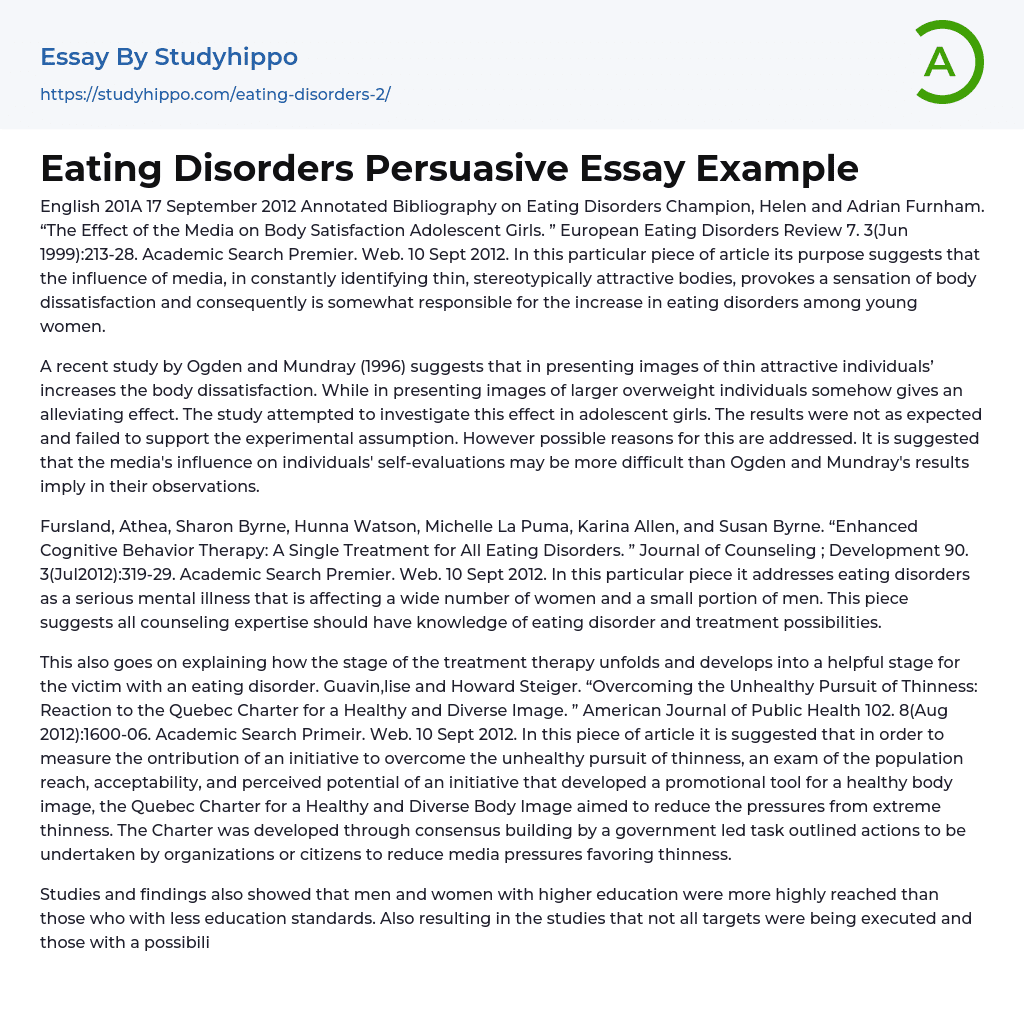In this particular piece of article its purpose suggests that the influence of media, in constantly identifying thin, stereotypically attractive bodies, provokes a sensation of body dissatisfaction and consequently is somewhat responsible for the increase in eating disorders among young women.
A recent study by Ogden and Mundray (1996) suggests that in presenting images of thin attractive individuals’ increases the body dissatisfaction. While in presenting images of larger overweight individuals somehow gives an alleviating effect. The study attempted to investigate this effect in adolescent girls. The results were not as expected and failed to support the experimental assumption. However possible reasons for this are addressed. It is suggested that the media's influence on individuals' self-evaluations may be more difficult than Ogden and Mundray's results imply in their observations.
Fursland,
...Athea, Sharon Byrne, Hunna Watson, Michelle La Puma, Karina Allen, and Susan Byrne. “Enhanced Cognitive Behavior Therapy: A Single Treatment for All Eating Disorders. ” Journal of Counseling ; Development 90. 3(Jul2012):319-29. Academic Search Premier. Web. 10 Sept 2012. In this particular piece it addresses eating disorders as a serious mental illness that is affecting a wide number of women and a small portion of men. This piece suggests all counseling expertise should have knowledge of eating disorder and treatment possibilities.
This also goes on explaining how the stage of the treatment therapy unfolds and develops into a helpful stage for the victim with an eating disorder. Guavin,lise and Howard Steiger. “Overcoming the Unhealthy Pursuit of Thinness: Reaction to the Quebec Charter for a Healthy and Diverse Image. ”
In this piece of article it is suggested that in order to measure
the ontribution of an initiative to overcome the unhealthy pursuit of thinness, an exam of the population reach, acceptability, and perceived potential of an initiative that developed a promotional tool for a healthy body image, the Quebec Charter for a Healthy and Diverse Body Image aimed to reduce the pressures from extreme thinness. The Charter was developed through consensus building by a government led task outlined actions to be undertaken by organizations or citizens to reduce media pressures favoring thinness.
Studies and findings also showed that men and women with higher education were more highly reached than those who with less education standards. Also resulting in the studies that not all targets were being executed and those with a possibility of having higher risks were not responding in the pursuit of overcoming unhealthy thinness. Martinez-Gonzalez, Miguel Angel, and Pilar Gual. “Parental Factors, Mass Media Influences, and the Onset of Eating Disorders in a Prospective Population- Based Cohert.
In this particular article their understanding was set to identify risk factors for eating disorders. A community company study was conducted in Navarra, Spain. The study of 2862 girls who were 12 to 21 years of age completed the Eating Attitudes Test and other questionnaires. Girls who scored high in the Eating Attitudes Test were interviewed by a psychiatrist who applied Diagnostic and Statistical Manual of Mental Disorders. Girls who were free of any eating disorder were reassessed after 18 months of follow-up using the same methods.
The results were that ninety new cases of eating disorders according to Diagnostic and Statistical Manual of Mental Disorders were identified during the follow-up. Our results support the
role of mass media influences and parental marital status in the onset of eating disorders. The habit of eating alone should be considered as a warning sign of eating disorders. In this particular article according to studies and experimental trails conducted in labs over the past decade suggests that thin-ideal internalization is an important risk factor for creating body image and eating disorders. Also noting of prospective risk factors and variables that may alter and add to the studies done before.
Physical and mental problems are important risk factors that initiate from the discomfort of the body image and eating disorders. Findings from studies suggest that internalization is a causal risk factor for body-image and eating disorders, and that it appears to fulfill in conjunction with other established risk factors for these outcomes, including dieting and negative affect. Future research is needed to examine the specific factors like perhaps family, peer, and media influences that promote internalization and also to replicate and extend prospective and experimental studies.
- Insanity essays
- Bias essays
- Big Five Personality Traits essays
- Body Image essays
- Mind essays
- Motivation essays
- Phobias essays
- Thought essays
- Adhd essays
- Antisocial Personality Disorder essays
- Anxiety essays
- Bipolar Disorder essays
- Depression essays
- Depression And Anxiety essays
- Dyslexia essays
- Learning Disability essays
- Major Depressive Disorder essays
- Mental Disorder essays
- Mental Illness essays
- Psychosis essays
- Schizophrenia essays
- Stress essays
- Suicide essays
- John Locke essays
- 9/11 essays
- A Good Teacher essays
- A Healthy Diet essays
- A Modest Proposal essays
- A&P essays
- Academic Achievement essays
- Achievement essays
- Achieving goals essays
- Admission essays
- Advantages And Disadvantages Of Internet essays
- Alcoholic drinks essays
- Ammonia essays
- Analytical essays
- Ancient Olympic Games essays
- APA essays
- Arabian Peninsula essays
- Argument essays
- Argumentative essays
- Art essays
- Atlantic Ocean essays
- Auto-ethnography essays
- Autobiography essays
- Ballad essays
- Batman essays
- Binge Eating essays
- Black Power Movement essays




